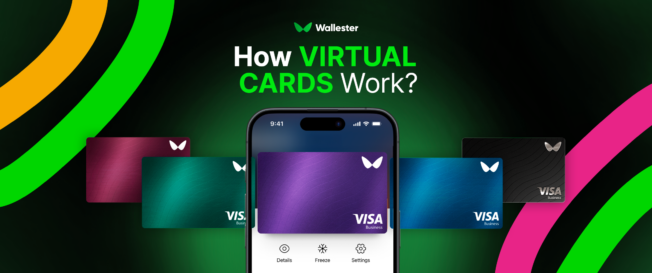Virtual cards appear deceptively simple on the surface – just digital numbers that work like regular payment cards. Behind this simplicity lies sophisticated fintech technology that makes them more secure, flexible, and controllable than traditional plastic cards. The advanced systems powering virtual cards handle everything from instant card generation to real-time fraud prevention, all while maintaining compatibility with existing payment networks.
Understanding how virtual cards work helps explain why they offer superior security, instant issuance, and granular spending controls that physical cards cannot match. The technology stack involves tokenisation, API integrations, real-time authorisation systems, and intelligent spending controls working together seamlessly.
In this post, we’ll examine the real technology behind virtual cards: how they’re created, secured, issued, and used in practice.
Quick Glossary
Get familiar with core terms before diving deeper:
- Tokenisation – A security process that replaces sensitive card data with a non-sensitive token used during transactions.
- BIN (Bank Identification Number) – The first 6–8 digits of a card number that identify the issuing bank or institution.
- MCC (Merchant Category Code) – A four-digit code that classifies a merchant by type of goods or services.
- CVV (Card Verification Value) – A 3- or 4-digit security code used to authenticate card-not-present transactions.
- API (Application Programming Interface) – A set of tools allowing different software systems (e.g., finance apps and card platforms) to interact programmatically.
- Issuer – The bank or financial institution that provides and manages your virtual card account.
What Happens When You Create a Virtual Card?
Creating a virtual card triggers a sophisticated process that happens within seconds. When you click “generate card” in your business platform, the system immediately communicates with the card issuer’s infrastructure to request a new payment instrument. This request includes your specified parameters like spending limits, merchant restrictions, and expiry dates.
The issuer’s system generates a unique 16-digit card number following standard payment card formatting rules. This number gets linked to your business account and funding source, while the spending controls you’ve set become embedded in the card’s logic. The entire process – from request to active card – usually completes in under 30 seconds.
Unlike physical cards that require manufacturing and shipping, virtual cards exist purely as data records in secure databases. The card details get stored across multiple secure servers with redundant backups, making them more reliable than physical cards that can be lost or damaged.
Each virtual card receives its own unique identifier within your business account, allowing you to track, modify, or deactivate specific cards without affecting others. This individualised approach gives you precise control over every payment instrument your company uses.
Further Reading: The Complete Guide to Virtual Cards for Business.
Tokenisation: The Security Core of Virtual Cards
Tokenised payments rely on a process that replaces static card data with single-use tokens, reducing exposure to fraud and making transactions more secure. Instead of exposing your actual card number during transactions, the system generates a unique token that represents your card for that specific purchase or merchant.
When you make a payment, the merchant receives this token rather than your real card details. The token only works for that particular transaction or merchant, becoming useless if intercepted by fraudsters. Even if someone gains access to the token, they cannot use it elsewhere or reverse-engineer your actual card information.
| Why Tokenisation Is More Than Just Encryption? Unlike encryption, which scrambles data but still requires decryption, tokenisation replaces data entirely with unrelated values. There’s nothing to decrypt – because the original card number is never transmitted at all. This approach makes it far harder for fraudsters to access meaningful information, even in the event of a breach. |
This differs from traditional card security, where your card number remains static and vulnerable across all transactions. If your physical card number gets compromised, every place you’ve used it becomes a potential security risk. With tokenised virtual cards, each transaction uses different tokens, isolating potential breaches to single instances. This model represents a modern approach to fintech security, where dynamic protection mechanisms replace static card numbers, reducing exposure to fraud.
The tokenisation process happens automatically without any additional steps from users. The payment networks (Visa, Mastercard) handle token generation and management, while your virtual card provider manages the linking between tokens and your actual account. This layered approach is a key driver of virtual card security, offering businesses a safer alternative to static card numbers and outdated fraud prevention tactics.
Further Reading: Virtual Card Fraud Prevention: How Secure Are They?
Virtual Cards and BIN Infrastructure
While tokenisation focuses on securing individual transactions, virtual card functionality also depends on how payment networks recognise and process each card – and that begins with BIN infrastructure.
Bank Identification Numbers (BINs) determine how payment networks route transactions and identify the card issuer. Every virtual card starts with a BIN that tells the payment system which bank issued the card and how to process transactions.
BIN routing works identically for virtual and physical cards, allowing virtual cards to function within existing payment infrastructure. When you use a virtual card online or through mobile wallets, the payment network reads the BIN and routes the transaction to the correct issuer for authorisation.
Businesses can choose between shared BINs (used by multiple companies) or custom BINs (dedicated to their organisation). Shared BINs offer faster setup and lower costs, while custom BINs provide greater control and branding opportunities. Large enterprises often prefer custom BINs for better transaction tracking and reporting.
BIN configurations can also vary by region. For example, EU-issued BINs may be more suitable for European operations, while US BINs often serve North American businesses more effectively. These choices can affect transaction routing and compliance but are typically managed by your card issuer or platform.

Spend Controls and Real-Time Authorisation
Virtual cards incorporate sophisticated spending controls directly into their authorisation logic. These controls operate in real-time, evaluating every transaction attempt against your predetermined rules before approving or declining payments.
- Spend limits work at multiple levels simultaneously. You can set daily, weekly, or monthly limits, along with per-transaction maximums. The system tracks spending across all these timeframes, automatically declining transactions that would exceed any limit.
- Merchant Category Code (MCC) controls restrict cards to specific business types. A card designated for advertising spend will only work with social media platforms, search engines, and approved marketing vendors. Attempts to use the same card at restaurants or retail stores get declined automatically.
- Expiration dates provide another control layer, with cards automatically becoming inactive after predetermined periods. Unlike physical cards with fixed expiry dates, virtual cards can have custom expiration times ranging from hours to years, depending on their intended use.
- Whitelisting and blacklisting functions allow you to specify exactly which merchants can accept your cards. Whitelisted cards only work with approved vendors, while blacklisted cards work everywhere except specified merchants.
The real-time authorisation system processes these controls within milliseconds of each transaction attempt. The system reviews each transaction attempt in milliseconds, checking spending patterns, merchant type, and timing to decide whether to approve or decline it.
These controls are embedded directly into the card logic through modern APIs or comprehensive platforms like Wallester, which allow businesses to configure, apply, and update spending rules programmatically as part of their core payment infrastructure.
Further Reading: Top Use Cases for Virtual Cards in Business
How Virtual Cards Are Used at Checkout
Once these controls are in place, virtual cards can be used across a wide range of payment environments with the same ease as traditional cards – both online and in-store.
Online checkout processes work identically for virtual and physical cards from the user’s perspective. The customer enters the virtual card number, expiry date, and CVV code just like any other payment method. Behind the scenes, the payment flows through the same Visa or Mastercard networks used by traditional cards.
One-time-use virtual cards become inactive immediately after successful payment, making them ideal for high-risk transactions or unfamiliar merchants. Reusable virtual cards function like traditional cards but maintain all the programmed spending controls and security features.
Apple Pay and Google Pay compatibility allows users to add virtual cards to their mobile wallets for contactless payments. The cards work at any terminal accepting contactless payments, extending virtual card utility beyond online transactions. The mobile wallet adds another security layer through biometric authentication.
Dynamic CVV and expiry options represent advanced virtual card features offered by some providers. These cards generate new security codes for each transaction or periodically update expiry dates, making them nearly impossible to compromise through data breaches.
Transaction processing happens through established payment networks, meaning virtual cards work everywhere that accept Visa or Mastercard. Merchants don’t need special equipment or software to accept virtual card payments.
How a Virtual Card Transaction Works
- User generates a card via a platform like Wallester, defining limits and controls.
↓
- Card details issued (16-digit number, CVV, expiry) and securely stored.
↓
- Payment initiated online or via mobile wallet.
↓
- Token generated instead of exposing real card data.
↓
- Transaction routed through Visa/Mastercard network using BIN.
↓
- Controls verified in real-time: MCC, limits, merchant rules.
↓
- Approval granted or denied based on logic embedded in the card.
↓
- Data sent to the accounting system via API if integrated.
Integration with Platforms and APIs
Modern virtual card providers offer comprehensive APIs that allow businesses to automate card generation, management, and monitoring. These APIs integrate with existing business systems, creating seamless workflows for finance teams and employees.
ERP system integration automatically generates virtual cards for approved purchase orders, with spending limits matching the order amounts. When procurement teams approve vendor payments, the system creates cards with exact spending limits and merchant restrictions, streamlining the payment process.
Accounting software integration captures transaction data in real time, automatically categorising expenses and updating financial records. Popular platforms like Xero, QuickBooks, and Sage connect directly with virtual card providers, eliminating manual data entry and reducing reconciliation time.
Spend management platforms use APIs to create sophisticated workflows around virtual card usage. These systems can automatically generate cards for different departments, projects, or expense categories while maintaining centralised oversight and control.
Developer-friendly features offered by leading providers include webhook notifications for real-time transaction alerts, bulk card generation capabilities, and detailed reporting APIs. These tools allow businesses to build custom integrations tailored to their specific needs and workflows.
Reliable providers offer tools that simplify technical integration, such as sandbox environments for testing, clear documentation, and hands-on developer support. These resources make it easier to integrate the virtual card system into your company’s existing workflows without disruption.
The Technology Advantage
The virtual cards backend combines multiple systems – APIs, tokenisation, and real-time controls – to provide seamless, secure transactions behind a simple user interface. Virtual card technology represents a significant advancement over traditional payment methods, combining the convenience of digital payments with refined security and control features. The underlying systems handle complex operations automatically while presenting simple interfaces to users.
The combination of tokenisation, real-time controls, and API integration creates a payment solution that adapts to modern business needs. Companies gain unprecedented visibility into spending patterns while maintaining the flexibility to respond quickly to changing requirements.
As businesses continue adopting digital-first approaches to financial management, understanding virtual card technology becomes increasingly important. The systems powering these cards will continue improving, adding new features and capabilities that further distance them from traditional payment methods.Looking to issue secure virtual cards with full API control? Explore how Wallester can help transform your business payment operations with advanced virtual card technology.


